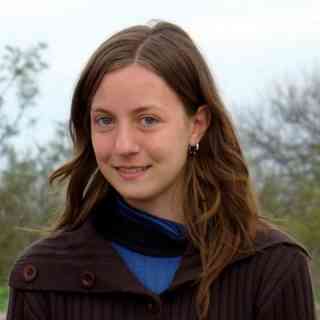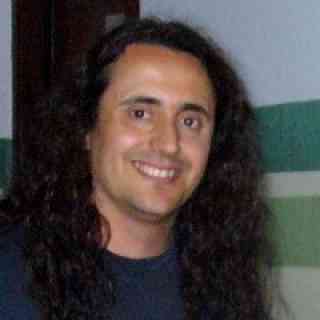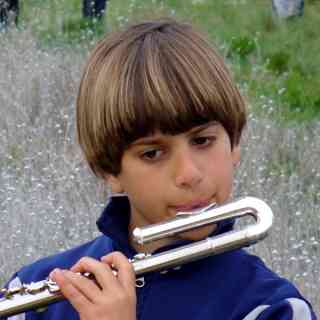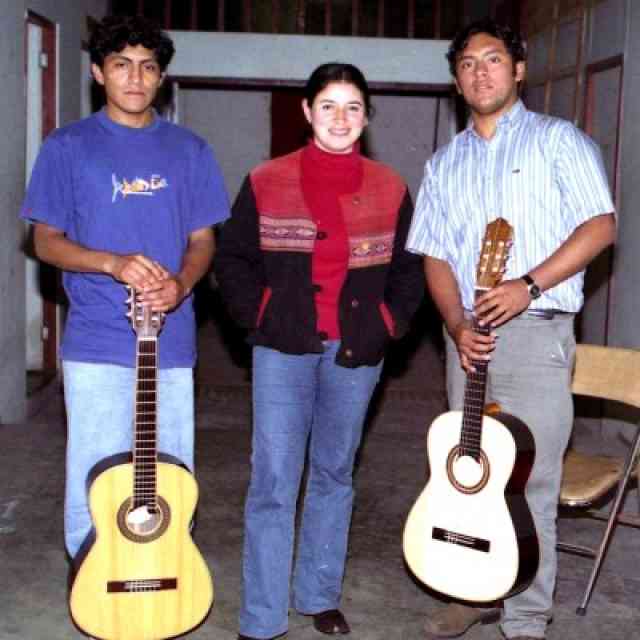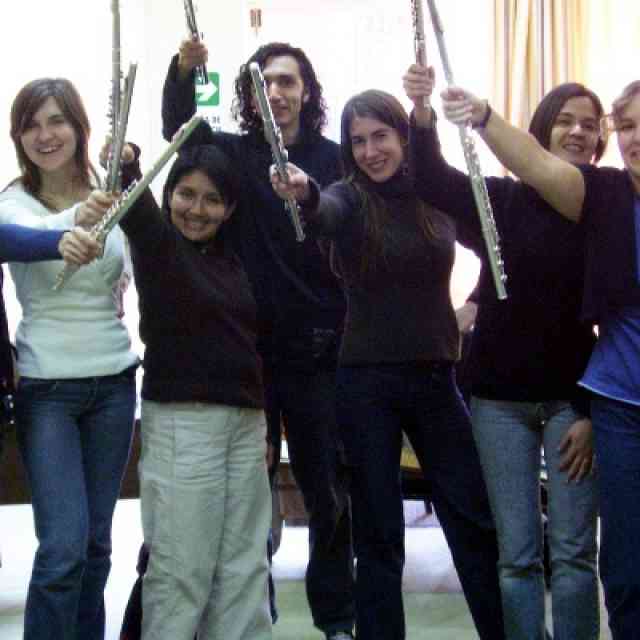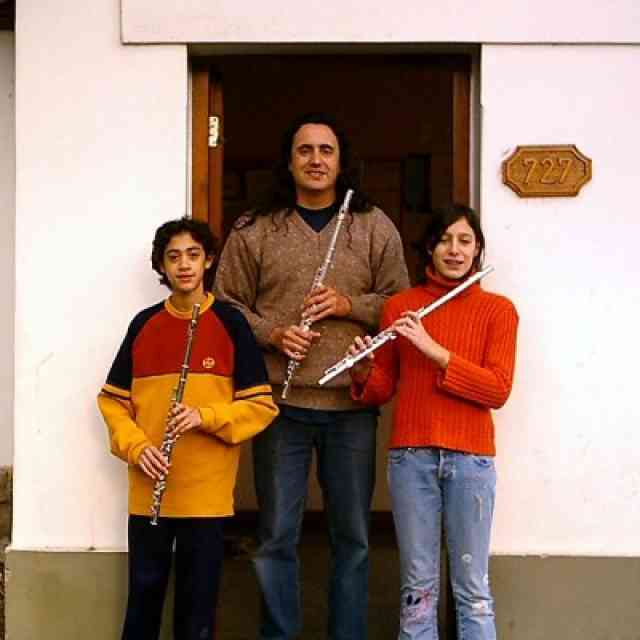Frequently in our lives, we plant a seed not knowing if or how it will grow, hoping for bounty and beauty. We do what we know to nurture its growth, but must leave much to chance and contingency, and wait to see what fruit our efforts might bear us. This is the story of a seed I planted, and how it grew.
My story begins in Lima, Peru, in January, 2005, when I attended the XX Festival Suzuki as a teacher trainee. I was the only “gringa” in my violin Book 10 class with Teacher Trainer, Doris Preucil. In addition to sharing music, ideas, and laughter with violin teachers from Colombia, Peru, Bolivia, Uruguay, Argentina, and Chile, I also met many teacher trainees of other instruments. I became good friends with one in particular, a flute teacher named Fernando Formigo, who lives and teaches in a small mountain town in Patagonia, Argentina called San Martín de los Andes.
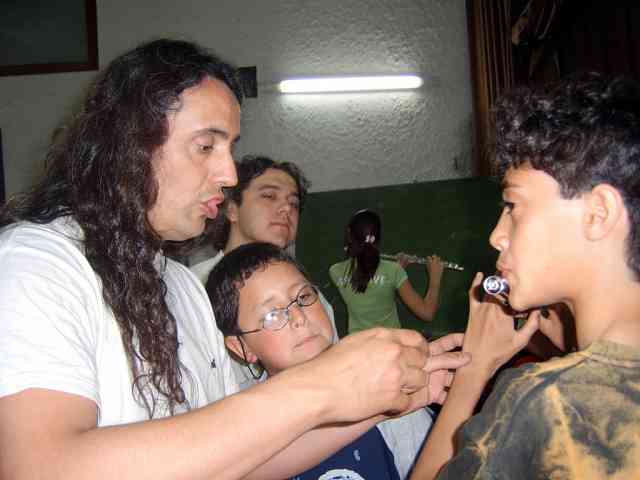
Fernando Formigo teaching flute.
Palo Alto, CA
April to September, 2005
Following my two weeks in Lima, Fernando and I exchanged occasional e-mail messages, and at some point in April he mentioned that he was undertaking to raise 8,000 pesos (approximately $3,000) in order to take his students to an upcoming Suzuki Festival, to be held in October, 2005, in Buenos Aires. My first thought was, “Wow, that’s so amazing! I’ll have to send him $100.” Several thoughts later, I wondered how on earth, in an economy still recovering from the 2001 devaluation of the Argentine peso, he would manage to accomplish this in six short months. One sleepless night, I decided I would not send him the $100, but instead use it to help Fernando raise the funds here in the US and Canada. I contacted as many flute teachers as I could locate, outlining plan and attaching a photo of one of Fernando’s group classes, which they call “ensemble.”
With an impressive 15% response to my email inquiry, I began to feel that this little dream of mine could possibly become a happy reality. I decided it would be safe to share my idea with Fernando. His effusive gratitude both terrified and motivated me. In my SAA directory, I highlighted and counted the total number of teachers, and determined that if 15 percent of the 240-plus registered teachers responded, I could raise everything Fernando and his students needed. I half jokingly named my project Proyecto Buenos Aires, and began the tedious process of printing, addressing, sealing, and stamping more than 200 “snail-mail” inquiries. And then, I waited on tenterhooks. Here and there, an email message or a phone call from one more interested colleague served to keep my hopes up. In all I received pledges from 11 North American flute teachers who were happy to participate. To each teacher, I sent a photo and a brief letter from one Argentine flute student, with a suggested goal of raising $100, in whatever fashion they preferred.
As I forwarded these photos and translated the letters with my rudimentary Spanish, I became more and more interested in the children and intrigued by their lives in San Martín de los Andes. At last, my emotional involvement in the project overcame me, and I determined that I would visit the town, hand deliver the proceeds of my fundraising, ride the bus 1000 miles with Fernando and his students, and attend the Festival with them in Buenos Aires. My excitement grew, as did my conviction that my little project was meaningful and important, irrespective of its ultimate outcome.
San Martín de los Andes, Neuquen, Patagonia, Argentina
March to September, 2005
Over the weeks and months, Fernando recounted the highlights of their own fundraising projects, as well as all the practicing aimed toward their sojourn in Buenos Aries. More than once, they performed in a local Galeria of shops, taking in up to $40 in an hour of playing. A very successful bingo game at the local casino brought in six times that amount. In an even larger project, they brought in Puente Celeste, a well-known world-music group, from Buenos Aires, adding the proceeds from this concert to their coffers. Most impressive of all, Fernando and a handful of parents and adult students organized the IV Encuentro Internacional de Vientistas, a three-day festival of performances and presentations ranging from Tango flute to didgeridoo to sikus (the indigenous Andean flute constructed of cane) , bringing in representatives from all across Argentina and Chile. The work to put on this encuentro was gargantuan, including advertising, bringing in presenters, and preparing and serving food for all of the 180 participants.
For six months, 30 students of all ages met every Friday to prepare their ensemble pieces. In the absence of a piano accompanist, Fernando himself arranged more advanced second and third parts to many of the book 1 and 2 pieces. They also prepared the Boismortier a minor concerto for five flutes. As he outlined to me later, the first challenge was to organize the group, establish the routine of regular rehearsals, and convince everyone of the importance of their individual contribution. In this small, isolated mountain town, there is only one Flute teacher, only two Suzuki teachers, and only one ensemble of its kind. It is not difficult to imagine the sometimes Sisyphean battle of gaining and maintaining support for such an ambitious project in such a new climate.
San Martín de los Andes
October, 2005
The breathtakingly beautiful town of San Martín de los Andes (SMA) is situated in a valley at one end of a meandering glacial lake, Lago Lacar, with the dramatic backdrop of the Andes visible from every angle. There are no stop signs, no neon signs, no billboards and no buildings over three stories high. The predominant architectural style favors that of the Swiss Alps, lending great charm to the already exquisite setting.
I arrived in spring and the newness of the season added to the excitement. My reception in SMA was equally breathtaking. I felt like royalty, as I was treated to homemade pizza and empanadas, taken on excursions in the mountains and on the lake, and offered an apartment to live in for my week-long stay. The children were equally warm and receptive, asking all manner of endearing and surprising questions about California, my students, the English language, and all of them so eager to play their flutes for me, to share and communicate through music. Hearing them play, it seemed to me that joy was everywhere. As I observed lessons and classes, enjoyed typical Argentine meals, and chatted in my comically bad Spanish, I began to fully understand just how important this trip was to each and every student and parent involved.
Fernando is one of many music teachers who teach in the Escuela de Musica, a large house converted for the purposes of private lessons as well as various types of ensembles and theory classes. One evening, I was energetically interviewed by three teachers, who were very interested in the music education system here in the States. I was surprised and impressed to learn that in Argentina, public music schools, although separate from regular public schools, are funded by the province, and students attend these schools free of charge. What a perfect environment for the ideals of the Suzuki Method, without a financial sacrifice for families!
At this time, there is no violin teacher in SMA or its environs (nor has there ever been), and I was invited to play for three schools, a newly established private music school for children under 9 years old, a small rural school in the town of Meliquina with no music program at all, and a private arts-oriented school where Fernando’s 11-year-old daughter is enrolled.
At each school, my instrument and I were warmly and enthusiastically received, and the children were fascinated. A year earlier, many had seen and heard a group of Suzuki violinists who visited from Córdoba, but for some this was their first in-person exposure to the instrument. Fernando later commented to me, “To the people here, I am Flute; you, Violin.” Music is such a central part of their culture, yet instruments like the violin and flute are rare and cherished, as are opportunities to study them.
One major purpose of the trip to the Buenos Aires Festival was for Fernando himself to give a workshop presenting his ideas and experiences as a Suzuki flute teacher to other interested flute teachers new to the method. A significant component of this workshop was to allow the “workshoppers” to observe Fernando teaching his students, to see the method in action, and to enjoy firsthand the results of his teaching. Not only is his flute program unique to San Martin de los Andes, it is unique to Argentina.
On the Bus
October 10-11, 2005
The morning of our departure was sunny and cool, with a wind coming off the lake. As we waited for our bus to pull in, entire families—parents, siblings, and grandparents—arrived to see their flutists off to the capital. Somehow, we all managed to check our luggage and settle ourselves on the bus. These buses are like none I’d ever seen, with fully reclining seats, movies, and hot meals. (I had had horrific visions of bumping tortuously along in a school bus.) I had also spent a lot of time wondering how the students would entertain themselves for the 20-hour ride through the highlands and across the Argentine desert. I should not have worried. After perhaps an hour, when simply looking out through the windows provided no more excitement, the instruments began to come out of their cases, and music full of eager delight filled the bus. I was again enchanted by the joy with which all the flutists played their instruments, young and old, beginner and advanced, to pass the time.
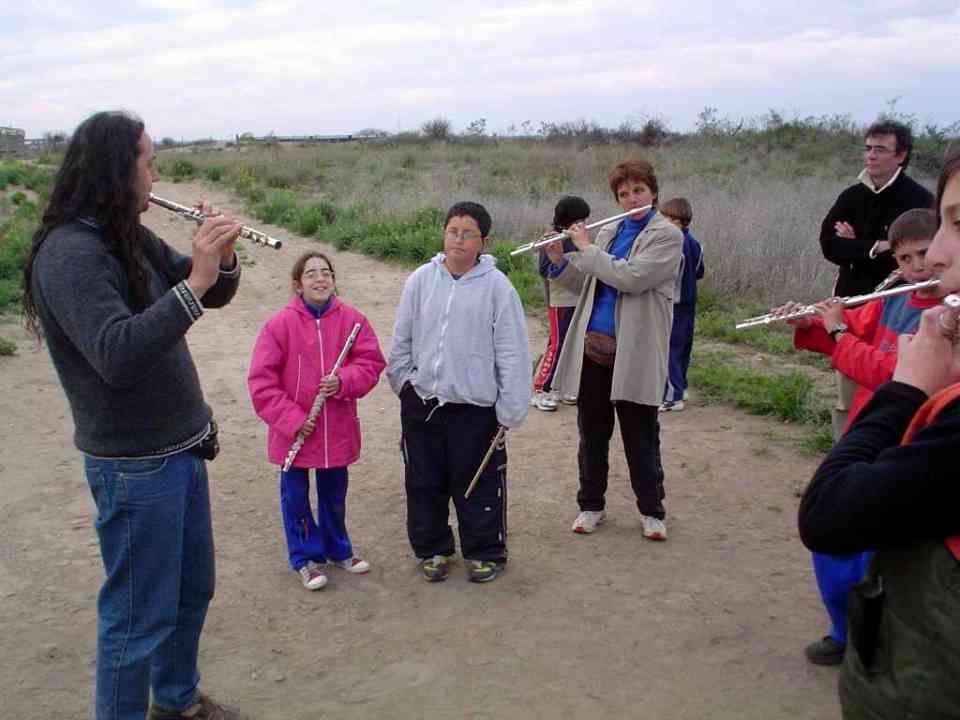
Practicing in the pampa when the bus broke down.
Later, sitting next to an adult student, Iris, I asked her about her flute studies. An artist and a former volleyball player, Iris was raised in SMA on a berry farm. She had taken a few flute lessons years before, but hadn’t connected with her teacher. With Fernando, she has been studying for about a year, and is clearly blossoming as an amateur musician. When I asked her what her thoughts were regarding the trip and the Festival, she responded with a shrug and a smile, “I am like a child.”
Hours later, flutes packed safely back in their cases, many of the younger children heading towards slumber, our seemingly wonderful bus broke down. A clamor of young voices erupted into the darkness. After multiple unsuccessful attempts to quiet the excited children, I told them I would play my violin if they would only try to be quiet. The silence was immediate and magical. I started with Brahms’ Waltz from Book 2, and then his famous Lullaby, trying to still the energy on the bus. After each piece, they applauded and I encouraged them to clap silently, gently tapping their fingers to their thumb. It may have only been 20 minutes, but it seemed to me I played for hours, anything I could pull out of my dusty memory, to a hushed group of children, in the darkness of night, stranded four hours away from any town on the infamous Argentine pampas. Much to our surprise and consternation, we were still there the next morning. While waiting in the cool morning for our relief bus, the other passengers, parents and I were treated to an early concert and a group class. If not for the flute, we would not have been there in the first place, but if not for the flutes we had with us, we would not have weathered the 12 hour delay nearly so well.
Buenos Aires
October 11-14, 2005
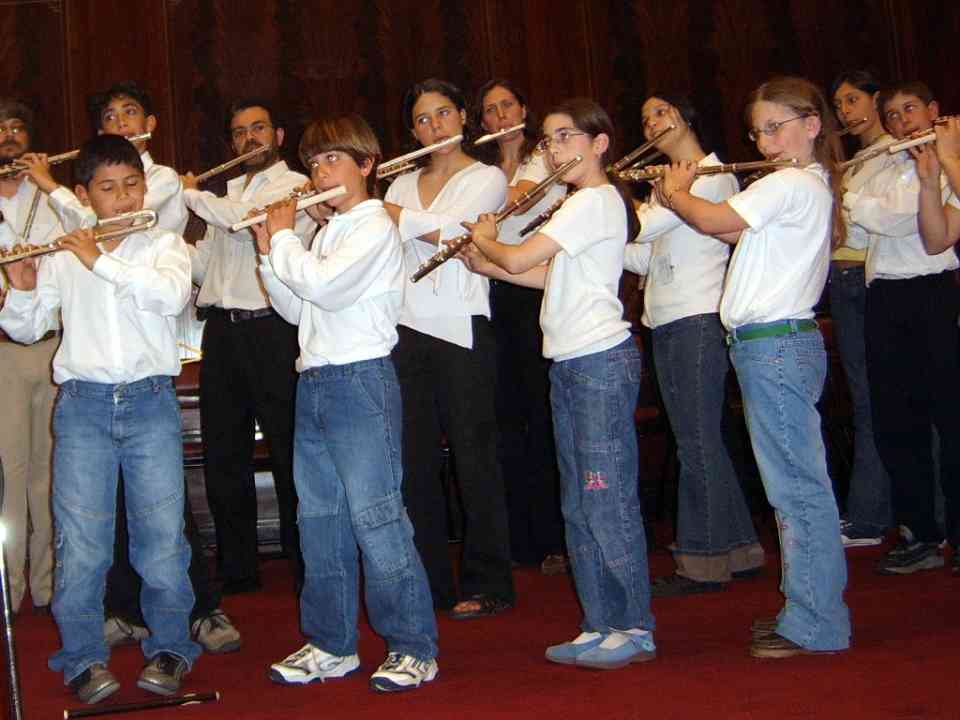
Final flute concert at the festival in Argentina.
We arrived to our destination 11 hours late, tired, hot and dirty. Fernando and his students had missed the entire first day of the four they were scheduled to spend at the festival. This, however, made the remaining three days that much more meaningful, and much was accomplished. The ensemble performed an outstanding mini-concert on the following day, and while Fernando presented his workshop, many of the students had master classes with Gerry Carey. The workshop participants were impressed by and interested in the Suzuki Method, and clearly enjoyed Fernando’s presentation as well as the performance. Gerry’s remarks and manner with the students were warm, interested and encouraging, and they clearly benefited from the first outside input most of them had ever received. In a particularly moving moment, one bright and spunky young student was brought to tears by the transformation he heard in his own sound. Watching the children respond to and absorb everything that was new and exciting to them was almost like being one of them myself.
The first evening saw dinner and a group class in the courtyard of their hostel; the second evening was all too sadly my last in Argentina. On the rooftop deck of our host and hostess, both Suzuki cello teachers in Buenos Aires, I observed one last ensemble rehearsal, ate one last empanada, sipped one last glass of Argentine wine. As the evening wore on, a violin teacher trainee from Cordoba treated us to a beautiful concert of solo Bach, and I offered an imperfect but heartfelt farewell performance of Ziguenerweisen. As I kissed and hugged each new friend goodbye, my heart felt so full of love and wonder. And I realized that I had gained more than I had given. I knew I might never see any of these wonderful people again, but I had been offered the ultimate gift of being unconditionally welcomed into their hearts and their world. My little seed was already bearing fruit.
Where Do We Go From Here?
Palo Alto, November 2005
I have always admired the eloquence of Dr. Martin Luther King, Jr. Like Dr. King, Dr. Suzuki had a dream, a vision of forming connections across artificial boundaries and borders, a vision of elevating the spirit of his people and of humankind, and a vision of a better world tomorrow for the children of today.
And in my own small corner of the garden, I am growing my own small vision: that one day, every Suzuki student in North America will have a fast friend in another country, and that every Suzuki teacher will have a strong, joyful, and reciprocal relationship with a foreign colleague, and that when they finally meet, they will recognize and know one another first and foremost through their music. It is often the gift of music that draws us to one another; may it be music too that keeps us together.
Where do we go from here? Many places, I hope. Many towns, many bus rides, many proyectos, many festivals. There are enthusiastic, loving, talented Suzuki teachers all across Latin America. And because of these special individuals, there are many more lovely young musicians growing in their teachers’ care. But there is also much work to be done before we can consider our Suzuki Association to be “of the Americas,” truly and equally. If one small, solitary seedling can grow and bear us fruit, why should we not cultivate an entire garden, even an orchard? As I see it, the possibilities of where we go from here are limitless.
This project was entirely a homegrown endeavor, not backed by any recognized or official organization, and that the level of trust required by those who took part, to send money to a complete stranger is huge. Together, we raised $1000, or one-third of the necessary funds. My gratitude to all who contributed is immeasurable; it was my honor and privilege to represent each and every one of you in San Martín de los Andes and in Buenos Aires. I would like to formally recognize the following wonderful teachers and their students, without whom my seed would never have pushed through the soil: Kelly Williamson (ON), Virginia Thingpen (CA), Tricia Snell (OR), Karen Perkins (UT), Junie Turner (FL), Eleanor Farjeon (CO), Joyce Davis and the Suzuki Music School, Inc. (IN), Vicki Blechta (ON), and Sasha Garver (CO). I envisioned and planted the seed, but you covered it with warm earth, watered it, provided nutrients and sunlight, and gave it the chance to grow. Some plants live only for a year or a season; others become great trees, capable of outliving us, bestowing their fruit upon generation after generation. My fervent hope is that this will prove to be the latter.
